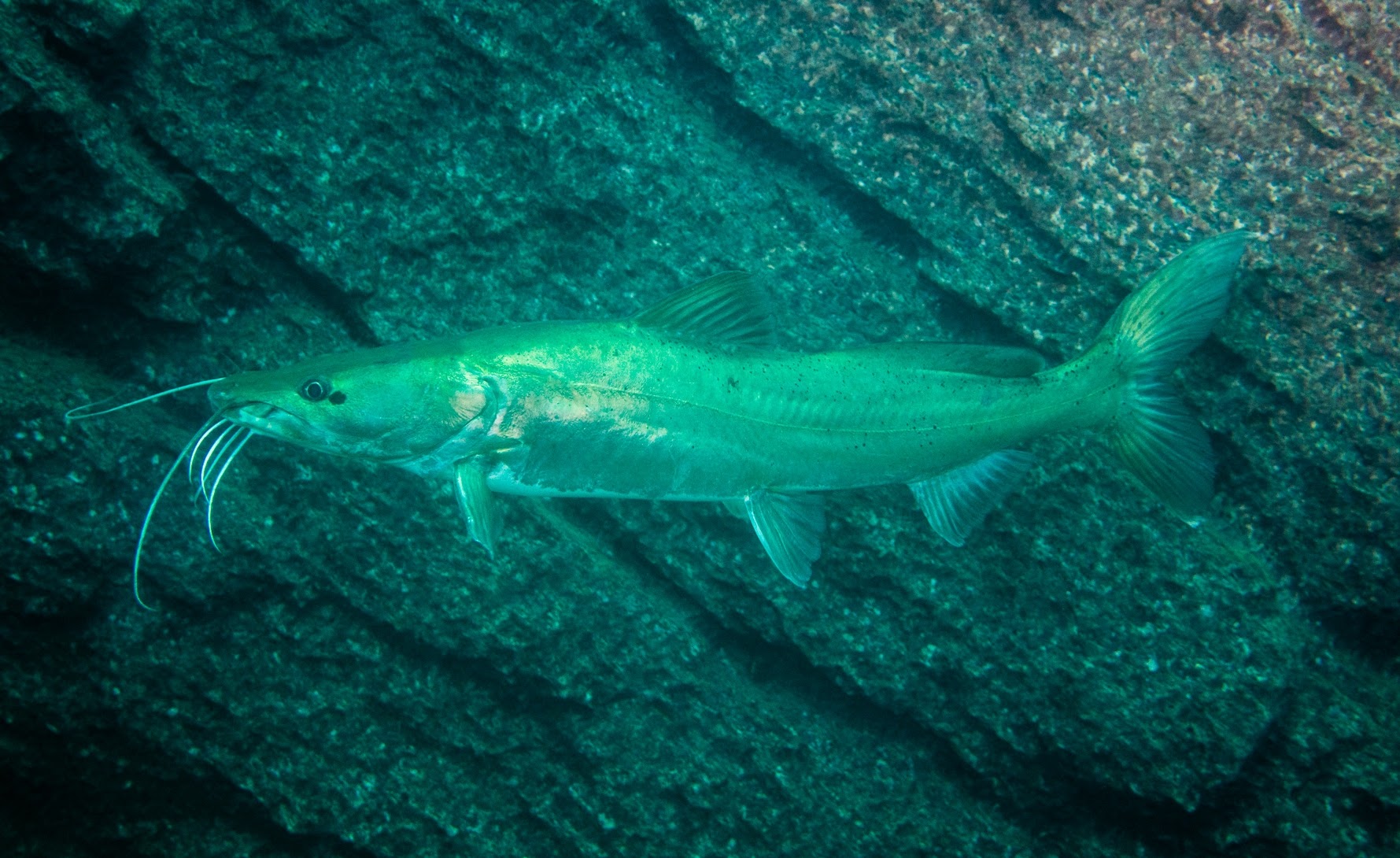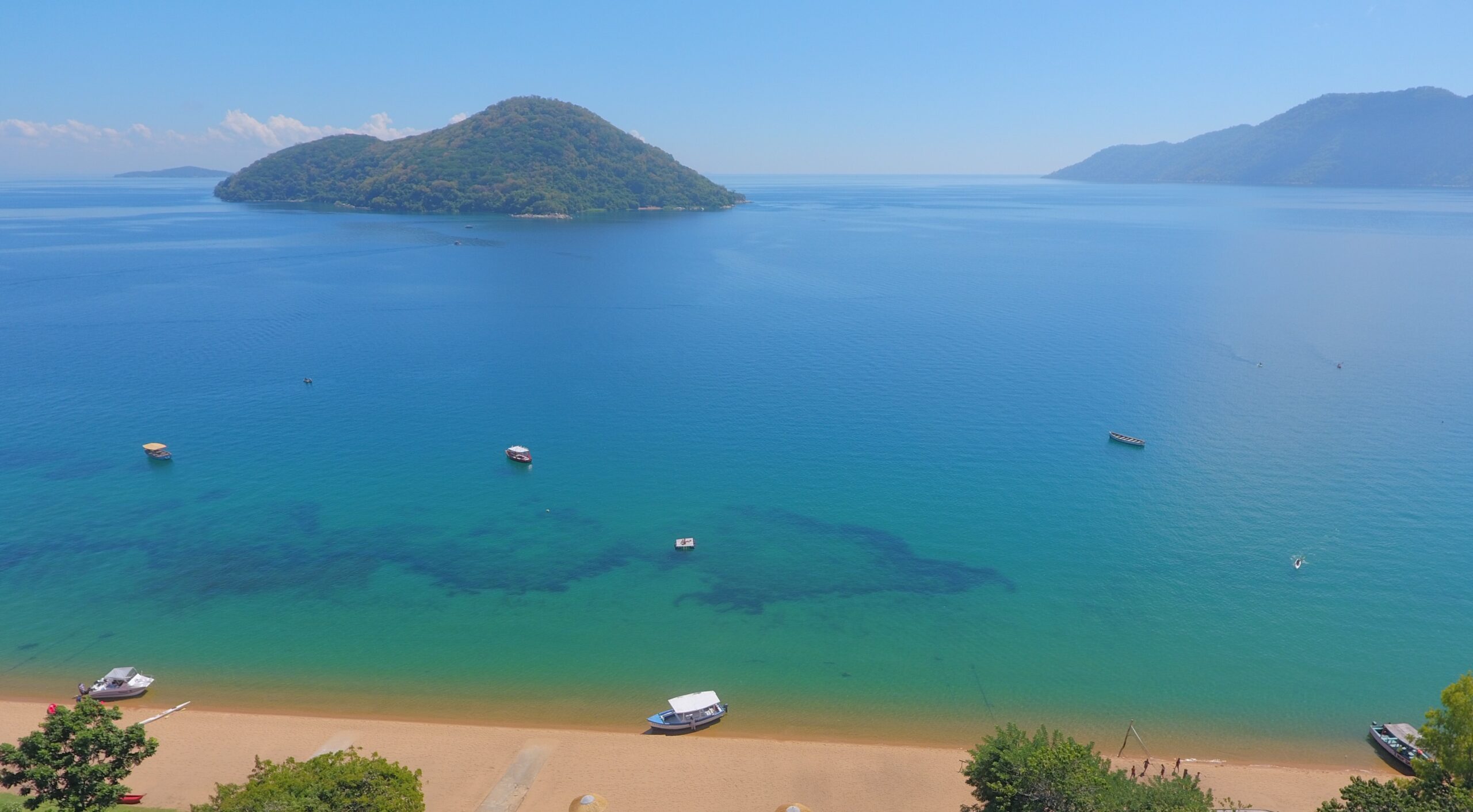I’ve been lucky enough to go diving and snorkelling on Lake Malawi now for over a decade. I first arrived on the shores of Lake Malawi at night and after a truly African adventure of a journey. The sun had long since set and aside from the electric lights at the dive shop / hotel the darkness was almost complete. To this day, I still remember that breath-taking view as I left my room the next morning to find coffee and a bite to eat before my first dive. The clear glistening waters went as far as the eye could see and the azure blue African sky, so often described in novels and travel shows, was almost blinding. It was at that very moment that I fell head over heels in love with Malawi and that was before I had seen what was under the water!
Top Lake Malawi facts:
By volume Lake Malawi is both the 5th largest freshwater lake (larger than Wales) & the most biodiverse on the planet. At 360 miles long and 12 (to 47) miles across it has been aptly nicknamed the calendar lake, as anyone who has had the pleasure of hearing famous local musician Michael Mountain’s most popular song with the chorus of “How big is the lake? It’s so big, it’s so big” can attest. Although it is more popularly known as The Lake of Stars- named by explorer David Livingstone as he saw the lights of fishermen’s boats sparkling like stars across the water. Originally called Lake Nyasa, back when Malawi was known as Nyasaland until gaining its independence and changing its name to Malawi in 1964.
Many travellers are surprised to learn that Lake Malawi offers scuba diving and those who brave putting on a mask and dunking their heads underneath the surface are in for a real treat. Most people associate lake diving as a cold location with almost no visibility, however Lake Malawi completely shatters these preconceptions. Visibility is often comfortably above 10 metres, the water a soothing 23-29 degrees Celsius, topographies of both sandy havens and cathedralesque rock structures and 700 to 1000 different species of Cichlid. These fish, endemic to Malawi, are some of the most varied, brightest and most colourful freshwater fish you’ll ever see. It is often referred to as a vast aquarium, which is more accurate than you might originally think as almost 90% of freshwater aquarium fish originate from Lake Malawi. Any pet shop with a respectable aquarium fish selection will almost certainly have a Malawi section.
Lake Malawi National Park, situated in the south, proudly claims UNESCO world heritage status, not only for its outstanding natural beauty both above and below the water but also for the colourful and beautiful Cichlid fish (known locally as “mbuna”) whose importance to evolutionary study is comparable to that of the finches of the Galapagos Islands (first studied by Charles Darwin in 1835). One of the more popular individual evolutionary quirks to observe in Cichlids is found in the aptly named Mouth Breeder. This female fish protects her young when a predator or threat is thought to be close by scooping her many small baby Cichlids into her mouth until the danger passes. This UNESCO status means this section of the lake and its surrounding areas will be protected from excessive development or damage and maintains its pristine and natural beauty for travellers from all around the world to enjoy.
What to see:
Once you have a snorkel or a diving regulator in your mouth, you’ll quickly see the array of beautiful aquatic life all around you. Cichlids of every shape and colour swim in all directions, schools of young Chambo and Mcheni stick in the shallows until they’re large enough to brave the deeper waters, blue crabs scuttle between cracks in the rocks or side walk along the sand, occasionally raising their small claws at any overly inquisitive divers, catfish dart in and out of vision up from the depths or out from some darkened rocky crevice (some young and small while others growing to almost 6 feet in length) and the blur of an occasional eel as it moves a few metres out of the realms of visibility.
Where to dive or Snorkel:
Before you pack your dive kit and book the next flight here, let me woo you with even more good news for divers and snorkelers!
The dive sites are accessible from the popular tourist destination Cape Maclear with a busy PADI dive shop Cape Maclear Scuba which offers a variety of courses from the beginners Open Water Dive Course all the way through Advanced Open Water, Rescue Diver up to Divemaster. Discover Scuba Dives are also available for those wanting just a small taste of the visual extravaganza available just below the surface whereas qualified divers can enjoy guided dive trips for as little as $50 a dive. With over 10 dive sites to choose from, some with swim throughs, some with sandy bottoms and others with magnificent cliffs and rock structures, you might not believe these sites to be at the same place if it wasn’t for the constant presence of the tropical and brightly coloured Cichlids. There is even a small ship wreck located 30 metres below the surface where ginormous catfish reside. This is the perfect place to acquire your Deep Dive certificate should you be planning to travel on to dive in Mozambique (where the best stuff to see is often deeper than the standard 18 metres depth).
The dive shop Aqua Africa in the north offers one of the best night dives you’ll ever dive (as featured in David Attenborough’s Planet Earth TV series). With the sun setting in the distance you find yourself kitted up, dive torch in hand as you complete a back roll entry into the lake and slowly descend into the darkening waters. As you’re guided past rock structures, through small gulleys and then swim along the edge of an underwater cliff, you will be joined, often one by one by African Freshwater Dolphin Fish, a species named due to their visual similarities to the Bottlenose Dolphin with some growing to a metre in length. This fish suffers from poor eyesight so rely on their own electric magnetic field to hunt. These inquisitive and intelligent creatures have learned that with the assistance of night divers’ torches to help their normally abysmal eyesight they’re able to hunt even more effectively. Sometimes you’ll be swimming underwater with a pack of 10+ Dolphin Fish twisting and turning around you and occasionally bumping into your arm or tank.
For those wanting to be surrounded by water, there are a selection of islands on the lake which offer diving.
In the north, Malawi’s largest and most populated island, Likoma island. One is able to fly directly from Malawi’s capital city Lilongwe or you can take the famous Ilalla ferry from a multitude of lakeshore destinations (I’d suggest booking a cabin). Once on Likoma Island there are a variety of gorgeous lake facing accommodations to stay at. Diving is available to guests at the exclusive and luxurious Kaya Mawa resort or can be booked through their sister company, a beachside backpackers named Mango Drift. Diving from Mango Drift is available for all whether you’re staying at the backpackers or elsewhere on the island.
Blue Zebra Island Lodge, an idyllic luxury retreat located a short 90 minute drive from Lilongwe city / airport and then a quick journey on a very comfortable speed boat. Blue Zebra not only boasts gorgeous lake view chalets and an infinity pool but their list of activities include kayaking, boat trips and snorkelling in the stunning waters of Lake Malawi National Park. The iconic blue striped cichlid the Blue Zebra is unsurprisingly abundant in the waters surrounding Nankoma island.
Mumbo & Domwe Islands are two beautiful eco-camp destinations (one mid range, the other budget) a few kilometres boat journey from the shores of Cape Maclear place you in an untouched natural paradise, with the chatter of tropical birds and lazy rock monitor lizards sunning themselves (you guessed it) on rocky outcrops. You’ll find yourself wandering the unpaved island pathways or being hypnotised by the lake views. Both islands offer kayaking, snorkelling and hiking to their guests. Booking a scuba dive is also possible and easy to arrange. The pristine clear waters and abundance of fish life guarantee you will not be left disappointed.
What to bring:
Whilst many experienced divers prefer the feel of their own kit, all of Malawi’s dive operations provide more than adequate shop kit (wetsuits, masks, snorkels, fins, BCDs) to use included in the dive price (unless otherwise stated). The usual items are always advisable: sun cream, a hat, swimming trunks (although if forgotten it’s easy to buy a pair of tailored ‘happy pants’ made in the bright and vibrant chitenge material popular in this part of the world), a shirt or t shirt to keep out of the African sun, a bottle of water to stay hydrated between dives and of course for those already qualified divers, a go pro or underwater camera to capture the phenomenal beauty below the surface. One factor to definitely take into consideration is Bilharzia, also found in many areas of Africa, South America, Asia & the Caribbean. Worry not though, the medication Praziquantel is abundantly available in any pharmacy just take the tablets 6-8 weeks after your last dive, snorkel or paddle.
Why dive Lake Malawi?
Being one of the lakes on the rift valley, Lake Malawi gets deep pretty quickly which gives a particular advantage for us divers as you’re never stuck on a boat for hours and hours suffering an endless horizon of waves to reach that one special dive site miles from anything else. No, this is not something to worry about when travelling to Malawi with your dive kit & because of that most of you can leave those seasickness tablets at home. Almost all of the dive sites are under ten minutes away from shore which means you’ll save precious time, plus you’ll not need to worry about trying to eat a packed lunch on a cramped and bobbing boat between dives. Due to this fact, most of the dive operations have wooden boats made locally with an outboard engine attached so you’ll fit right in with the small fishing vessels heading along the shorelines. Your wake won’t upset the fishermen in smaller canoes, hand carved out of tree trunks, nor will it cause any nearby snorkelers to inhale water or any tourists enjoying a bit of kayaking or stand up paddle boarding to run the risk of being toppled into the warm waters as you pass.
These sandy beaches and nearby dive sites also make Malawi a first choice location to introduce yourself into the world of diving. The Open Water course is very well priced, plus the sandy shallows are the perfect location for practising skills. The concern of cutting yourself or damaging decades of fragile oceanic growth is non-existent and for the time being this relatively undiscovered dive haven assures smaller classes, meaning a more one on one experience with your dive instructor. The diving is so pleasant and easy, it’s a no-brainer for first timers and experienced divers alike. Besides, anyone who’s enjoyed a post dive beer in any popular divers’ bar around the world will know all too well how quickly divers stories can turn into ‘I bet you’ve never’ brags. I can say with confidence that not nearly enough divers can claim to have blown bubbles anywhere near the rift valley, let alone dived the gorgeous waters of the most biodiverse lake on the planet! I can’t promise you much in life, but if you come to dive Lake Malawi, I promise you won’t be disappointed.



